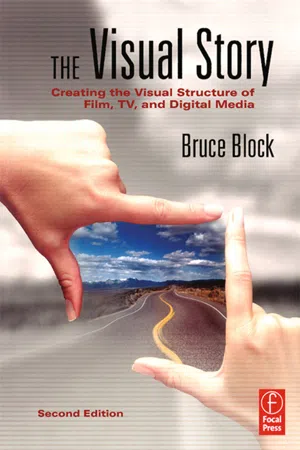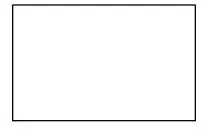![]()
CHAPTER 1
The Visual Components
The Cast of Visual Characters
Everywhere we go, we’re confronted by pictures. We look at still pictures in books, magazines, and at museums. We watch moving pictures at the movies, on television, at concerts, and in theatres; we play video games and surf the Internet. We look at a lot of pictures—big, little, moving, still, color, or black and white—but they are all pictures.
This book is about learning how to understand and control these pictures.
Every picture is comprised of a story, visuals, and, sometimes, sounds. Used together, these three elements communicate the meaning of the picture to the viewer. If the picture is an advertisement, the viewer may be persuaded to purchase a product. If the picture is a computer game, the story, visuals, and sound can make the game addictive. If the picture is a movie, the viewer can become emotionally affected.
Pictures can be broken down into three fundamental building blocks:
- Story: Building blocks of plot, character, and dialogue
- Sound: Building blocks of dialogue, sound effects, and music
- Visuals: What are the building blocks of the visuals? Scenery? Props? Costumes? These answers are too limited—the building blocks for all visuals are the basic visual components.
The Basic Visual Components
The basic visual components are space, line, shape, tone, color, movement, and rhythm.
These visual components are found in every moving or still picture we see. Actors, locations, props, costumes, and scenery are made of these visual components. A visual component communicates moods, emotions, ideas, and most importantly, gives visual structure to the pictures. This book discusses these basic visual components in relation to television, computer, and movie screens, although these components are used in creating any picture.
SPACE
This is not outer space or “giving someone his or her space.” There are three kinds of visual space: first, the physical space in front of the camera; second, the space as it appears on a screen; and third, the spatial size and shape of the screen itself.
LINE AND SHAPE
Line is a perceptual fact. It exists only in our heads. Line is the result of other visual components that allow us to perceive lines, but none of the lines we see is real. Shape goes hand in hand with line, because all shapes appear to be constructed from lines.
TONE
Tone refers to the brightness of objects in relation to the gray scale. Tone does not refer to the tone of a scene (sarcastic, excited, etc.), or to audio tone (treble and bass). Tone is an important factor in black & white and color photography.
COLOR
One of the most powerful visual components, color is also the most misunderstood. Basic color education is usually misleading and confusing. This book will simplify the complex component of color and make it simpler to understand and use.
MOVEMENT
Movement is the first visual component to attract the eye. Movement occurs using objects, the camera, and the viewers’ eyes as they watch the screen.
RHYTHM
We’re most familiar with rhythm we can hear, but there’s also rhythm we can see. Rhythm is found in stationary (nonmoving) objects, moving objects, and editing.
Understanding and Controlling Visual Components
These are our cast of characters, the basic visual components: space, line, shape, tone, color, movement, and rhythm. Although we may be more familiar with the other cast called actors, both casts are critical to producing great work. Once production begins, the visual component cast will appear on-camera in every shot, communicating moods and emotions to the audience just like the actors. That’s why understanding and controlling the visual components is so important.
Since actors have been introduced, we should take a moment to discuss them. An actor is a unique object to place on the screen. It is the actor’s appearance, personality, and talent that attract an audience. The actor communicates by talking, making facial expressions, and using body language, but an actor is also a combination of spaces, lines, shapes, tones, colors, movements, and rhythms. So, in that respect, there’s no difference between an actor and any other object.
Whether it is an actor, the story, the sound, or the visual components, audiences react emotionally to what they see and hear. Music easily communicates moods or emotions. Hitchcock’s Psycho (1960) or Spielberg’s Jaws (1975) demonstrate how music signals “terror” to the audience. In both films, music warns the audience that the murdering mother or the menacing shark is present. In Psycho it’s the screech of the violins, and in Jaws it’s the pounding notes of the bass. In both cases, the filmmaker introduces the musical theme when the murderous character first appears and then, by repeating that theme, reminds the audience of the threat. The music communicates fear, tension, and horror.
The same communication can occur using a visual component. Certain visual components already have emotional characteristics associated with them, although most of these visual stereotypes are easily broken. “Red means danger” is a visual stereotype. But green or blue could also communicate danger. Blue can mean “murder” to an audience, if it is properly defined for them. If every murder in a story occurs in blue light, the audience will expect a murder whenever blue light is presented to them. This is the concept used in Sidney Lumet’s Murder on the Orient Express (1974). Once the blue color and its meaning are established, the audience accepts the idea and reacts accordingly.
In fact, any color can indicate danger, safety, good, evil, honesty, corruption, etc. Although stereotypes effectively prove that visual components can communicate with an audience, they’re also the weakest, perhaps least creative use of the components. Visual stereotypes are often inappropriate, dated, and derivative. Any visual component can be used to communicate a wide range of emotions or ideas in new and interesting ways.
Can you decide not to use the visual components in your production? No; if you ignore the visual components, they won’t go away. Color can be eliminated by shooting in black & white, but it’s impossible to eliminate any other visual component, because they exist in everything on the screen. Even a blank screen contains the visual components of space, line, shape, tone, and movement. So the screen is never empty. Even a still photograph uses the components of rhythm and movement. Since the visual components are always on screen, understanding, controlling, and using them are critical to great picture making.
Defining the visual components opens the door to understanding visual structure, which can be a guide in the selection of locations, character design, colors, set dressing, props, typography fonts, wardrobe, lenses, camera positions, composition, lighting, actor staging, and editorial decisions. Understanding the visual components will answer questions about every visual aspect of your pictures.
Remember, though, that any study, if blindly adhered to, can be misleading. It’s not the purpose of this book to leave you with a set of rigid textbook definitions and laws. If visual structure were that predictable anyone with a calculator could produce perfect pictures. Visual structure isn’t math—it’s not that predictable. Fortunately, there are some concepts, guidelines, and even some rules that will help you wrestle with the problems of producing a great visual production. The key is in the visual components.
In this book, I will explain each visual component. I’ll describe it, illustrate it, and show you how to use it. The purpose of this book is to enable you to use visual structure and make better pictures.
Terms
This book will introduce some new ideas and terminology. The following are a few terms that need defining now.
THE SCREEN
The screen refers to the two-dimensional screens where we watch pictures. This includes movie screens, television and computer screens, screens on cell phones and other hand-held devices, the canvases hanging in museums, and the pages in books and magazines that display photographs and drawings. All of these two-dimensional surfaces are screens.
REAL WORLD/SCREEN WORLD
The real world is the environment in which we live. It’s the three-dimensional place we inhabit. The screen world refers to images on any screen. It’s the picture world we create with cameras, pencils, brushes, and computers. Sometimes the two different worlds will follow the same visual rules; other times they will not.
FOREGROUND, MIDGROUND, AND BACKGROUND
This book will use the term foreground abbreviated as FG (objects close to the viewer or camera), midground or MG (objects that are farther away from the viewer or camera), and background or BG (objects that are farthest away).
THE PICTURE PLANE
In this book, frame lines will surround anything visual in the screen world. These frame lines create a picture plane.
The picture plane is the “window” within which the picture exists. These frame lines represent the height and width of this window or screen. The proportions of the screen will vary, but every screen is a picture plane.
In a museum, the actual frame around the painting defines the picture plane. The picture plane of a camera is the viewfinder or the aperture of the film plane. The picture plane of a television or computer is the edges of the screen. When we hold our hands up in front of our eyes to frame a shot, we make a window with our hands. That, too, is a picture plane.
VISUAL PROGRESSION
Discussions about structure always lead to a discussion about progressions. A progression begins as one thing and changes to something else. Music can make a progression from slow to fast, for example. There are also visual progressions. The following visual progression begins with something simple and changes to something complex.
The simplest object we...


